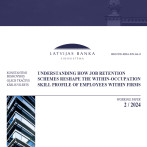Unemployment dynamics henceforth will depend on reducing structural unemployment
After falling rapidly since the last spring, it is not surprisingly that the pace of unemployment drophas moderated at the beginning of this year.Central Statistical Agency (CSP) Labour Force Survey (LFS) points to a 0.3 percentage points drop in the jobseekers rate within a quarter, reaching 16.6% of the economically active population in the first quarter of 2011. A slower drop in unemployment was determined both by the seasonal effect (in the first quarter of the year jobseekers rate usually increases compared to the previous quarter), and the smaller number of people involved in the temporary work programs provided by the State Employemnt Agency (NVA) (particularly the 100 lats programme) , i.e. 22.2 thousand people or 2.7 thousand less than in the previous quarter. If the seasonal effect and the influence of temporary jobs is taken in consideration, the percentage of jobseekers in the first quarter of 2011 continued to drop as rapidly as before.
As for the structure of the jobseekers, the number of long-term unemployed still keeps going up. However, this trend could alter already in the middle of the year as NVA data point to a decrease in the number of long-term unemployed (first time during recent 30 months)in April 2011. It must be noted that the number and the share of long-term jobseekers inherently lags behind the economic cycle and thus any increase by itself does not point to a problem of structural unemployment.
Structural unemployment or the inability of a part of the unemployed to meet the requirements of entrepreneurs is suggested by a number of other indicators. Business tendency indicators point that almost 10% of construction entrepreneurs regard a lack of workforce as the main factor impeding their business. That is more than in industry and services in spite of the fact that it was construction that experienced the most rapid drop in the number of workers during the economic crisis. Even if emigration is taken into account, the number of people with the previous work experience should be enough in this branch. Apparently, a part of those working in construction during the years of rapid growth do not have the necessary qualifications and currently it is qualified workforce that construction lacks. CSP workforce survey data also clearly point to a labour market segmentation by qualification. Among those with higher education, unemployment has almost returned to the pre-crisis levels, whereas among the population with basic education and among young people it is still close to 30%. Admitting to structural unemployment does not mean shaking off the problem to those who have it but, quite the opposite: an attempt to highlight the importance of knowledge and skills in the labour market as well as a serious reason for the government to make use of active employment measures (including professional education courses of high quality in the relevant industries) in order to bring structural unemployment down. Albeit it is clear that as the seasonal and cyclical unemployment component will continue to decline in the subsequent quarters of 2011 we will see a subsequent reduction of the jobseekers rate, in the longer perspective, it is reducing structural unemployment that will largely determine future dynamics of unemployment.
Textual error
«… …»




